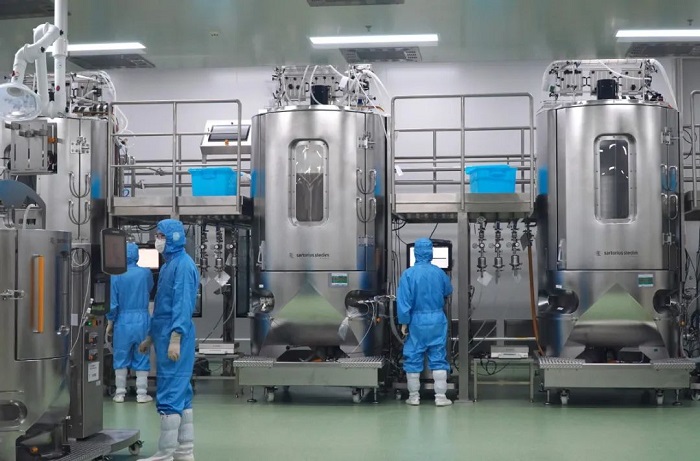Flu season sees spike in drug production
The surge in demand for respiratory disease medications in China has prompted significant output increases among major drugmakers, and industry experts foresee an increasing need for such remedies in the coming days.

▲Employees work at a drug production line in Yantai, Shandong province, on Jan 9. XU SUHUI/XINHUA
However, there is no danger of drug shortages nationwide, thanks to the country's pharmaceutical production capability and unlikelihood of panic buying among consumers, they said.
Since the start of the winter, China has seen a rise in acute infectious respiratory diseases, with the prevalence of multiple pathogens amid the ebbs and flows of infection spikes.
While influenza cases are currently at high levels, Liu Tonghua, former deputy president of the Beijing University of Chinese Medicine, said that it is possible that people will see repeated infections of one or multiple pathogens simultaneously.
"Winter and spring are usually peak seasons for respiratory diseases, and the natural immunity of recovered people can only work against the pathogens they overcome for limited durations. They may also contract illnesses from different pathogen variants," Liu said.
"In addition, people's ability to fight off infectious respiratory diseases may decline following repeated infections."
Lei Zhenglong, chief of the epidemic control and prevention division of the National Disease Control and Prevention Administration, said at a recent news conference that COVID-19 infections in China might rebound to a certain degree around the time of the Spring Festival holiday, due to a flurry of travel and large family gatherings.
According to online healthcare platform JD Health, sales of flu medication surged 340 percent and 13 percent, respectively, in the first 12 days of January compared with numbers for the same periods in November and December.
The first week of the year also saw sales of cold drugs, analgesic medicines and cough suppressants all surge by double-digit percentages from the last week of 2023, according to 111, Inc — a digital healthcare platform.
China National Pharmaceutical Group Corp, or Sinopharm, told China Daily that it has been proactively adjusting production plans and supply measures, including storing sufficient quantities of raw materials for traditional Chinese medicines (TCM) in advance.
Sinopharm's flagship respiratory disease products include Chinese patented drugs such as Jizhi Syrup and Sinusitis Oral Liquid, which are produced by its subsidiary Taiji Group. The company said its production lines for two key products have been running 24/7 to ensure daily output of Jizhi Syrup of 6,500 boxes and 1,000 boxes of Sinusitis Oral Liquid.
Meanwhile, relying on its national pharmaceutical distribution networks, Sinopharm has also ramped up efforts to accelerate the pace of drug distribution and enhance storage management to avoid shortages.
Since December, it has delivered more than 323,300 boxes of Jizhi Syrup and more than 44,200 boxes of Sinusitis Oral Liquid nationwide to places including Beijing, Shanghai, and Jiangsu and Guangdong provinces.
Swiss pharmaceutical company Roche — maker of innovative influenza drug Xofluza — said it has mobilized overseas supply chain resources to ensure stable quantities of the product in China, following a recent demand surge from both hospitals and pharmacies.
The company is also expanding the drug's entry into more Chinese hospitals, while cooperating with online healthcare platforms like JD Health, to facilitate drug accessibility for the general public. Currently, the drug is available in more than 1,600 hospitals across China.
Sichuan Good Doctor Panxi Pharmaceutical Co Ltd also said its output of Kanggan Granule, a signature TCM cold treatment, increased roughly 37 percent year-on-year in the past three months, to around 2.04 million packs a day.
Wen Jianguo, factory head of the company, said: "We see many large trucks waiting in line to load products every day at our warehouse. We have established special working groups on raw material procurement, logistical support and services supply, and organized workers into three shifts per day to produce drugs day and night to meet market demand at the fastest pace possible."
In addition, the company anticipates its daily production capacity will expand more than fivefold, as its smart factory will start operations soon. The latter is being built with an investment of 637 million yuan ($88.52 million) and covers an area of around 115,333 square meters, Wen said.
Experts said that enterprises can increase production and enhance distribution very quickly due to China's pharmaceutical industrial and supply chains' breadth and agility, and there is little chance for drug shortages.
"The production of relevant drugs has increased quickly with supply of raw materials being stable, and people are not likely to hoard drugs out of panic this time," said Zhou Mi, a senior researcher at the Chinese Academy of International Trade and Economic Cooperation.
"In addition, medical resources from other parts of the country will arrive very quickly if there are shortages of some drugs in some regions, making widespread shortages of pharmaceuticals unlikely," Zhou added.
Reporter: Liu Zhihua
